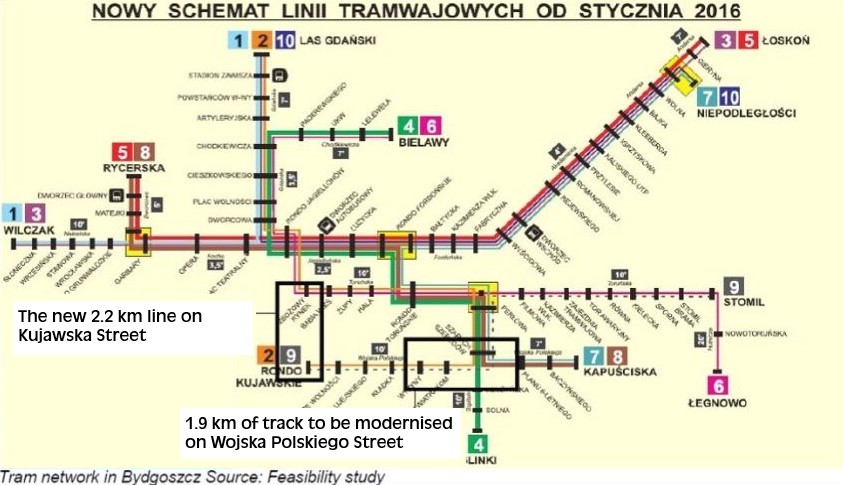The tram network in Bydgoszcz, Poland, is being improved with the construction of 2.2 km of double-track line along Kujawska Street, between the Bernardyńskie and Kujawskie roundabouts. Nearby roads will be reconstructed and extended and a new dual carriageway with a separate bus lane will be built.
- 14 May 2020
Modernisation of 1.9 km of double-track line along Wojska Polskiego Street is also planned. Both sections of track will be connected to the city’s intelligent transport system.
In addition, 15 new low-floor trams, 29-32 m long and 2.3-2.4 m wide, are to be purchased. Designed for a track gauge of 1 000 mm, they will be able to carry at least 200 passengers each and will have passenger information systems.
Further work involves installing overhead traction lines and lighting, linking the traction and lighting functions; establishing eight tram stops; and building or rebuilding pavements, pedestrian crossings, bus bays and bicycle paths.
A park-and-ride facility with 134 parking spaces will be built at the Kujawskie roundabout. Car parks on Ustronie and Długa streets and parking spaces on Kujawska Street will be renovated. Public utility infrastructure for water, sewage, telecommunications, electricity and gas will be adjusted as necessary. Noise mitigation measures will be undertaken, and 629 trees and 528 shrubs will be planted.
Outdated vehicles
With a population of around 350 000, Bydgoszcz is the joint capital – along with the city of Toruń – of the Kujawsko-Pomorskie region. It does not have a metro system, but is served by both buses and trams. Encompassing 10 lines, one of which operates only during rush hour, and about 40 km of track, the tram network is relatively dense. However, its efficiency would be enhanced by connections in – and modernisation of – certain sections.
A number of new trams have been added to the fleet over the past 12 years. Nonetheless, a substantial amount of the trams acquired in the 1980s remain in use. Although some were modernised in 2003, most need to be either upgraded or replaced. A particular problem is their high floors, which make access difficult for people with reduced mobility.
Increased comfort
The main objective of the project is to improve public transport in Bydgoszcz by extending the tram network, boosting its performance and enhancing its attractiveness. Passenger comfort will be increased, as will accessibility, especially for people with reduced mobility and visual and hearing impairments. New tariff policies will be adopted and measures, including a campaign to promote municipal transport, will be implemented to encourage more people to use the trams.
By providing a viable alternative to private cars, expanding pedestrian and cycle routes, and introducing more public transport stops and energy-efficient vehicles, the upgrades should reduce traffic congestion, accidents and greenhouse gas emissions. This will make the city more liveable, thus helping to generate investment and foster socio-economic development, particularly in the areas served by the new infrastructure and trams.
Total investment and EU funding
Total investment for the project “Construction of a tram line along Kujawska street, from Kujawskie roundabout to Bernardyńskie roundabout, together with the extension of the road network, reconstruction of the rail transport system and rolling stock purchase in Bydgoszcz” is EUR 86 579 938, with the EU’s Cohesion Fund contributing EUR 38 665 655 through the “Infrastructure and Environment” Operational Programme for the 2014-2020 programming period. The investment falls under the priority “Development of low-emission collective transport in cities”.

